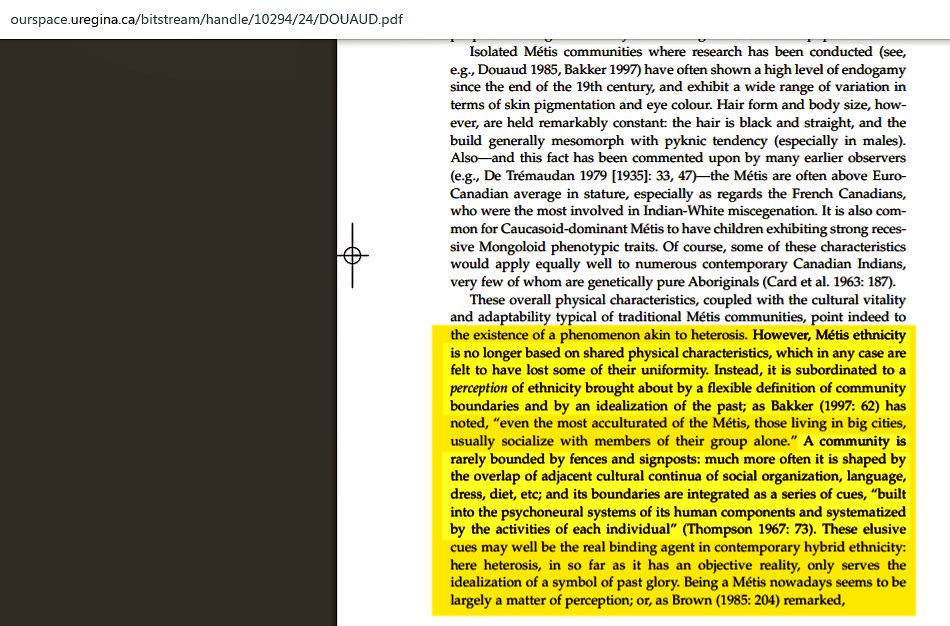
The western Métis : profile of a people-Douad, Patrick C 2007- Published by: University of Regina, Canadian Plains Research Center 

Manitoba History: Review: Patrick C. Douaud, editor, The Western Métis: Profile of a People by Susan Berry- Royal Alberta Museum, Edmonton- Number 58, June 2008 

The western Métis : profile of a people-Douad, Patrick C 2007- Published by: University of Regina, Canadian Plains Research Center - Concept of Metis - the word is related to the Spanish Mestizo, meaning a person of mixed ancestry. Both genetic and cultural half-breeds exist 

in the world. The Canadian Metis, are unique in that they were able to assert political and legal rights ... The Metis mostly Indian and French Canadian. 

Whereas the term Métis formerly characterized “less a racial category than an incipient ethnic group, entry into which could be acquired through marriage and self-designation, as well as birth” (Peterson 1978: 46), today it
is also an administrative and, since the 1982 Canadian
is also an administrative and, since the 1982 Canadian

Constitution Act, a legal definition. A Métis is now a person with any degree of Indian blood who is not registered on a reserve.
However, Métis ethnicity is no longer based on shared physical characteristics, which in any case are felt to have lost some of their uniformity. Instead, it is subordinated to a perception of ethnicity brought about by a flexible definition of community boundaries and 

by an idealization of the past; as Bakker (1997: 62) has
noted, “even the most acculturated of the Métis, those living in big cities, usually socialize with members of their group alone.” A community is rarely bounded by fences and signposts: much more often it is shaped by the
noted, “even the most acculturated of the Métis, those living in big cities, usually socialize with members of their group alone.” A community is rarely bounded by fences and signposts: much more often it is shaped by the
overlap of adjacent cultural continua of social organization, language, dress, diet, etc; and its boundaries are integrated as a series of cues, “built into the psychoneural systems of its human components and systematized by the activities of each individual” (Thompson 1967: 73)
The full story of métissage (racial mixing) as a sociocultural
and political phenomenon in northern North America
involves the study and understanding of a wide range of
individual and group experiences.
and political phenomenon in northern North America
involves the study and understanding of a wide range of
individual and group experiences.

The Métis Nation
The Métis people are often called “the offspring of the Canadian fur trade.” As the European fur traders in the east needed wives, they simply chose them from the Indian tribes whose territories overlapped the trade—mainly Cree and Ojibwa, both being close
The Métis people are often called “the offspring of the Canadian fur trade.” As the European fur traders in the east needed wives, they simply chose them from the Indian tribes whose territories overlapped the trade—mainly Cree and Ojibwa, both being close

relatives within the 𝗪𝗼𝗼𝗱𝗹𝗮𝗻𝗱𝘀 𝗰𝘂𝗹𝘁𝘂𝗿𝗲 𝗼𝗳 𝗔𝗹𝗴𝗼𝗻𝗾𝘂𝗶𝗮𝗻-𝘀𝗽𝗲𝗮𝗸𝗶𝗻𝗴 𝗔𝗯𝗼𝗿𝗶𝗴𝗶𝗻𝗮𝗹𝘀. From the 17th century on, as the fur
trade expanded westward, the Métis proliferated in Rupert’s Land./thecanadianencyclopedia.ca/en/article/abo…
trade expanded westward, the Métis proliferated in Rupert’s Land./thecanadianencyclopedia.ca/en/article/abo…

• • •
Missing some Tweet in this thread? You can try to
force a refresh


















